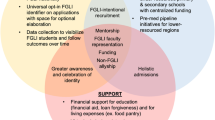Abstract
Objectives
This study examines the comparative distributions of postresident international medical graduates (IMGs) and US medical graduates (USMGs) in high and low poverty areas of US cities. Existing research has established that IMGs are more likely than USMGs to practice in urban areas, yet there is the question whether IMGs locate more frequently than USMGs in urban poverty areas.
Methods
Data from the 1997 AMA Physician Masterfile and 1990 US Census were merged to classify physicians' practices into low- and high-poverty areas in selected cities.
Results
In 14 cities with populations of 2.5 million or more, IMGs were located in a statistically significant disproportion in poverty areas of 7 cities. Of 36 cities with populations of 1,000,000 to 2,499,999, there were 5 cities that had significant IMG disproportions in poverty areas. Of a random sample of 27 cities with populations of 250,000 to 999,999, there were 2 cities that had significant IMG disproportions. Many cities in all three size categories had a large proportionate IMG complement of the total physician workforce located within high-poverty areas.
Conclusions
IMGs were found in disproportionate numbers in poverty areas in a number of US cities, especially the very largest ones. These findings are discussed in light of the current debate about a physician surplus and initiatives to reduce the number of IMGs in residency training.
Similar content being viewed by others
References
Mick SS, Lee S-YD. The safety net role of international medical graduates.Health Aff. 1997;16:141–150.
Mick SS, Lee S-YD, Wodchis WP. Variations in geographical distribution of foreign and domestically-trained physicians in the United States: “Safety-net” or “surplus exacerbation”?Soc Sci Med. 1999; in press.
Mullan F, Politzer RM, Davis CH. Medical migration and the physician workforce. International medical graduates and American medicine.JAMA. 1997;273;152–157.
Mick SS, Lee S-YD.An Analysis of the Comparative Distribution of Active Post Resident IMGS and USMGs in the United States in 1996. Rockville, MD: University of Michigan, Report to the Bureau of Health Professions, Health Resources and Services Administration, US Department of Health and Human Services; 1996.
Politzer RM, Cultice JM, Meltzer AJ. The contribution of international medical graduates to the geographic distribution of physicians in the US.Med Care Res Rev. 1998;55:116–130.
Mick SS, Lee S-YD. The distribution of post-resident primary care IMGs and US medical graduates according to geographic-based measures of need.Fed Bull. 1997;84:215–229.
Mick SS, Sutnick AI. International medical graduates in rural America. The 1987 distribution of physicians who entered the US medical system between 1969 and 1982.J Rural Health. 1996;12:423–431.
Baer LD, Ricketts TC, Konrad TR, Mick SS. International medical graduates in rural, underserved areas.Med Care. 1998;36:1534–1544.
Mick SS, Lee S-YD. Are there need-based geographical differences between international medical graduates and US medical graduates in rural US counties?J Rural Health. 1999;15(1):26–43.
Mick SS, Pfahler MN.Review and Synthesis of the Literature on Foreign Medical Graduates/International Medical Graduates 1980–1994. Rockville, MD: University of Michigan, Report to the Bureau of Health Professions, Health Resources and Services Administration US Department of Health and Human Services; 1995.
US Bureau of the Census.Census of Population and Housing, 1990 [United States]: Summary Tape File 3B [Computer file] Washington, DC: US Department of Commerce, Bureau of the Census; 1993.
US Bureau of the Census.Poverty Areas in Large Cities, PC80-2-81): 1980 Census of Population, Vol. 2. Subject Reports Washington, DC: US Government Printing Office; 1985.
Ellen JM, Kohn RP, Bolan GA, Shiboski S, Krieger N. Socioeconomic differences in sexually transmitted disease rates among black and white adolescents, San Francisco, 1990 to 1992.Am J Public Health. 1995;85:1546–1548.
Kreiger N. Social class and the black/white crossover in age-specific incidence of breast cancer. A study linking census-derived data to population-based registry records.Am J Epidemiol. 1990;131:804–814.
Kreiger N. Women and social class. A methodological study comparing individual, household, and census measures as predictors of black/white differences in reproductive history.J Epidemiol Community Health. 1991;45:35–42.
Kreiger N. Overcoming the absence of socioeconomic data in medical records. Validation and application of a census-based methodology.Am J Public Health. 1992;82:703–710.
Blalock HM.Social Statistics. New York: McGraw-Hill; 1972.
Institute of Medicine.The Nation's Physician Workforce. Options for Balancing Supply and Requirements. Washington, DC: National Academy Press; 1996.
Pew Health Professions Commission.Critical Challenges. Revitalizing the Health Professions for the Twenty-First Century. Third Report of the Pew Health Professions Commission. San Francisco: University of California at San Francisco Center for the Health Professions; 1995.
Council on Graduate Medical Education.Eleventh Report. International Medical Graduates and the Physician Workforce, and GME Payment Reform. Washington, DC: US Government Printing Office; 1998.
Whitcomb M. Correcting the oversupply of specialists by limiting residencies for graduates of foreign medical schools.N Engl J Med. 1995;333:454–456.
Cunningham R. New York demo proving effective at cutting residencies.Med Health. September 28, 1998;52:1.
American Medical Association. Graduate medical education.JAMA. 1998;280:836–845.
Salsberg ES, Wing P, Dionne MG, Jemiolo DJ. Graduate medical education and physician supply in New York State.JAMA. 1996;276:683–687.
Educational Commission for Foreign Medical Graduates. The ECFMG Clinical Skills Assessment is initiated.Outlook. 1998;20-21:1.
Conn HL Jr, Cody RP. Results of the second Clinical Skills Assessment Examination of the ECFMG.Acad Med. 1987;62:448–453.
Mullan F. Powerful hands. Making the most of graduate medical education.Health Aff. 1996;15:250–253.
Mullan F. The muscular samaritan: the National Health Services Corps in the new century.Health Aff. 1999;18:168–175.
Author information
Authors and Affiliations
Rights and permissions
About this article
Cite this article
Mick, S.S., Lee, SY.D. International and US medical graduates in US cities. J Urban Health 76, 481–496 (1999). https://doi.org/10.1007/BF02351505
Issue Date:
DOI: https://doi.org/10.1007/BF02351505



